Business Decision Making and Analytical Thinking Report
VerifiedAdded on 2020/06/04
|16
|4476
|70
Report
AI Summary
This report provides a detailed analysis of analytical thinking and decision-making processes within a business context. It begins by highlighting the importance of decision-making and the application of decision analysis for organizational effectiveness, emphasizing how decisions are based on critical analysis of factors and business problems. The report then outlines a specific decision problem related to an organization's expansion plans, followed by the application of the Simple Multi-Attribute Rating Technique (SMART) to structure and analyze the decision problem. The report also delves into the strengths and limitations of analysis in relation to the decision problem, culminating in a comprehensive evaluation of the decision-making process. The report covers key aspects such as defining the issue, establishing decision criteria, risk assessment, and the implementation and re-evaluation of decisions. The report uses a case study of a company, Anite, and its expansion plans to illustrate the practical application of the concepts discussed. The use of SMART technique for decision making is also explained.
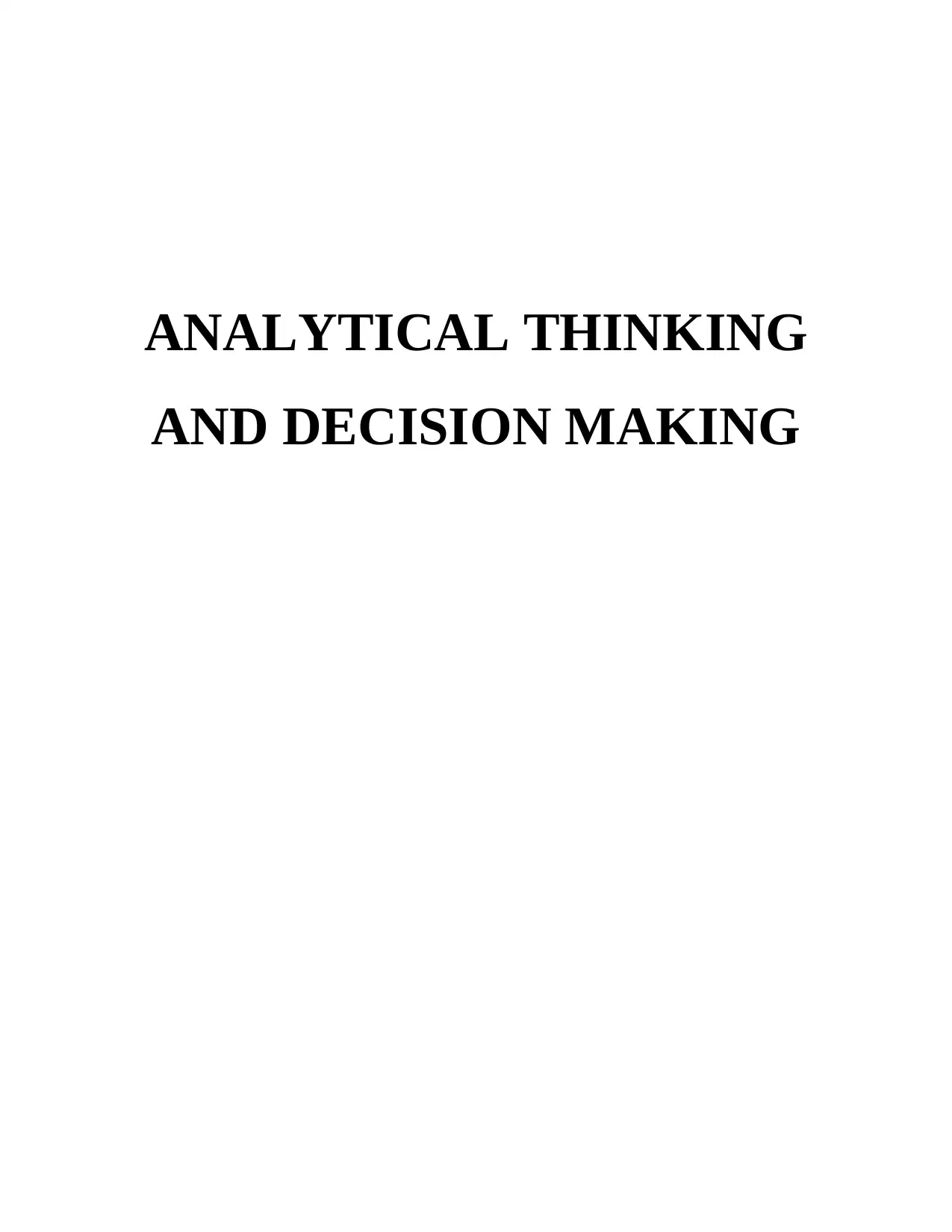
ANALYTICAL THINKING
AND DECISION MAKING
AND DECISION MAKING
Paraphrase This Document
Need a fresh take? Get an instant paraphrase of this document with our AI Paraphraser
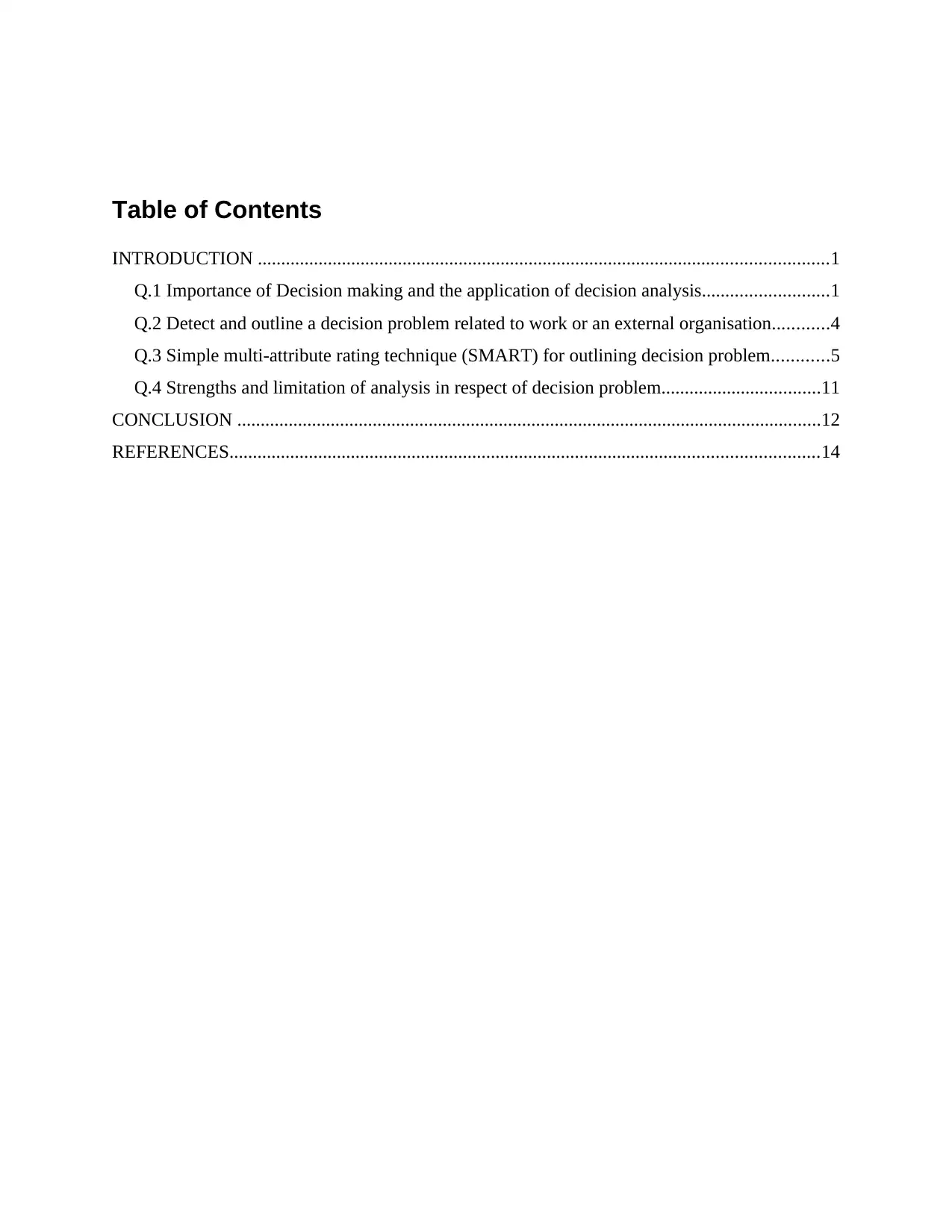
Table of Contents
INTRODUCTION ..........................................................................................................................1
Q.1 Importance of Decision making and the application of decision analysis...........................1
Q.2 Detect and outline a decision problem related to work or an external organisation............4
Q.3 Simple multi-attribute rating technique (SMART) for outlining decision problem............5
Q.4 Strengths and limitation of analysis in respect of decision problem..................................11
CONCLUSION .............................................................................................................................12
REFERENCES..............................................................................................................................14
INTRODUCTION ..........................................................................................................................1
Q.1 Importance of Decision making and the application of decision analysis...........................1
Q.2 Detect and outline a decision problem related to work or an external organisation............4
Q.3 Simple multi-attribute rating technique (SMART) for outlining decision problem............5
Q.4 Strengths and limitation of analysis in respect of decision problem..................................11
CONCLUSION .............................................................................................................................12
REFERENCES..............................................................................................................................14
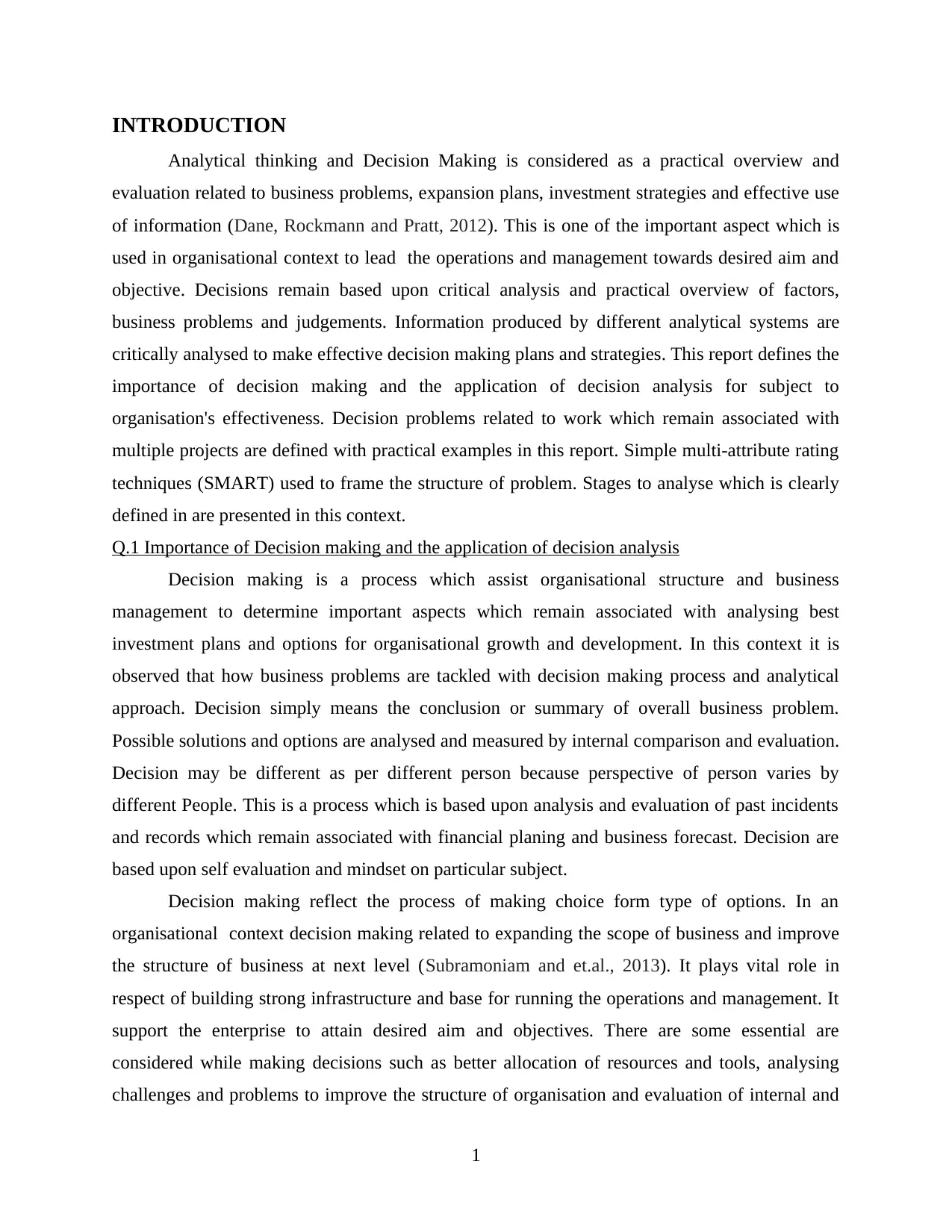
INTRODUCTION
Analytical thinking and Decision Making is considered as a practical overview and
evaluation related to business problems, expansion plans, investment strategies and effective use
of information (Dane, Rockmann and Pratt, 2012). This is one of the important aspect which is
used in organisational context to lead the operations and management towards desired aim and
objective. Decisions remain based upon critical analysis and practical overview of factors,
business problems and judgements. Information produced by different analytical systems are
critically analysed to make effective decision making plans and strategies. This report defines the
importance of decision making and the application of decision analysis for subject to
organisation's effectiveness. Decision problems related to work which remain associated with
multiple projects are defined with practical examples in this report. Simple multi-attribute rating
techniques (SMART) used to frame the structure of problem. Stages to analyse which is clearly
defined in are presented in this context.
Q.1 Importance of Decision making and the application of decision analysis
Decision making is a process which assist organisational structure and business
management to determine important aspects which remain associated with analysing best
investment plans and options for organisational growth and development. In this context it is
observed that how business problems are tackled with decision making process and analytical
approach. Decision simply means the conclusion or summary of overall business problem.
Possible solutions and options are analysed and measured by internal comparison and evaluation.
Decision may be different as per different person because perspective of person varies by
different People. This is a process which is based upon analysis and evaluation of past incidents
and records which remain associated with financial planing and business forecast. Decision are
based upon self evaluation and mindset on particular subject.
Decision making reflect the process of making choice form type of options. In an
organisational context decision making related to expanding the scope of business and improve
the structure of business at next level (Subramoniam and et.al., 2013). It plays vital role in
respect of building strong infrastructure and base for running the operations and management. It
support the enterprise to attain desired aim and objectives. There are some essential are
considered while making decisions such as better allocation of resources and tools, analysing
challenges and problems to improve the structure of organisation and evaluation of internal and
1
Analytical thinking and Decision Making is considered as a practical overview and
evaluation related to business problems, expansion plans, investment strategies and effective use
of information (Dane, Rockmann and Pratt, 2012). This is one of the important aspect which is
used in organisational context to lead the operations and management towards desired aim and
objective. Decisions remain based upon critical analysis and practical overview of factors,
business problems and judgements. Information produced by different analytical systems are
critically analysed to make effective decision making plans and strategies. This report defines the
importance of decision making and the application of decision analysis for subject to
organisation's effectiveness. Decision problems related to work which remain associated with
multiple projects are defined with practical examples in this report. Simple multi-attribute rating
techniques (SMART) used to frame the structure of problem. Stages to analyse which is clearly
defined in are presented in this context.
Q.1 Importance of Decision making and the application of decision analysis
Decision making is a process which assist organisational structure and business
management to determine important aspects which remain associated with analysing best
investment plans and options for organisational growth and development. In this context it is
observed that how business problems are tackled with decision making process and analytical
approach. Decision simply means the conclusion or summary of overall business problem.
Possible solutions and options are analysed and measured by internal comparison and evaluation.
Decision may be different as per different person because perspective of person varies by
different People. This is a process which is based upon analysis and evaluation of past incidents
and records which remain associated with financial planing and business forecast. Decision are
based upon self evaluation and mindset on particular subject.
Decision making reflect the process of making choice form type of options. In an
organisational context decision making related to expanding the scope of business and improve
the structure of business at next level (Subramoniam and et.al., 2013). It plays vital role in
respect of building strong infrastructure and base for running the operations and management. It
support the enterprise to attain desired aim and objectives. There are some essential are
considered while making decisions such as better allocation of resources and tools, analysing
challenges and problems to improve the structure of organisation and evaluation of internal and
1
⊘ This is a preview!⊘
Do you want full access?
Subscribe today to unlock all pages.

Trusted by 1+ million students worldwide
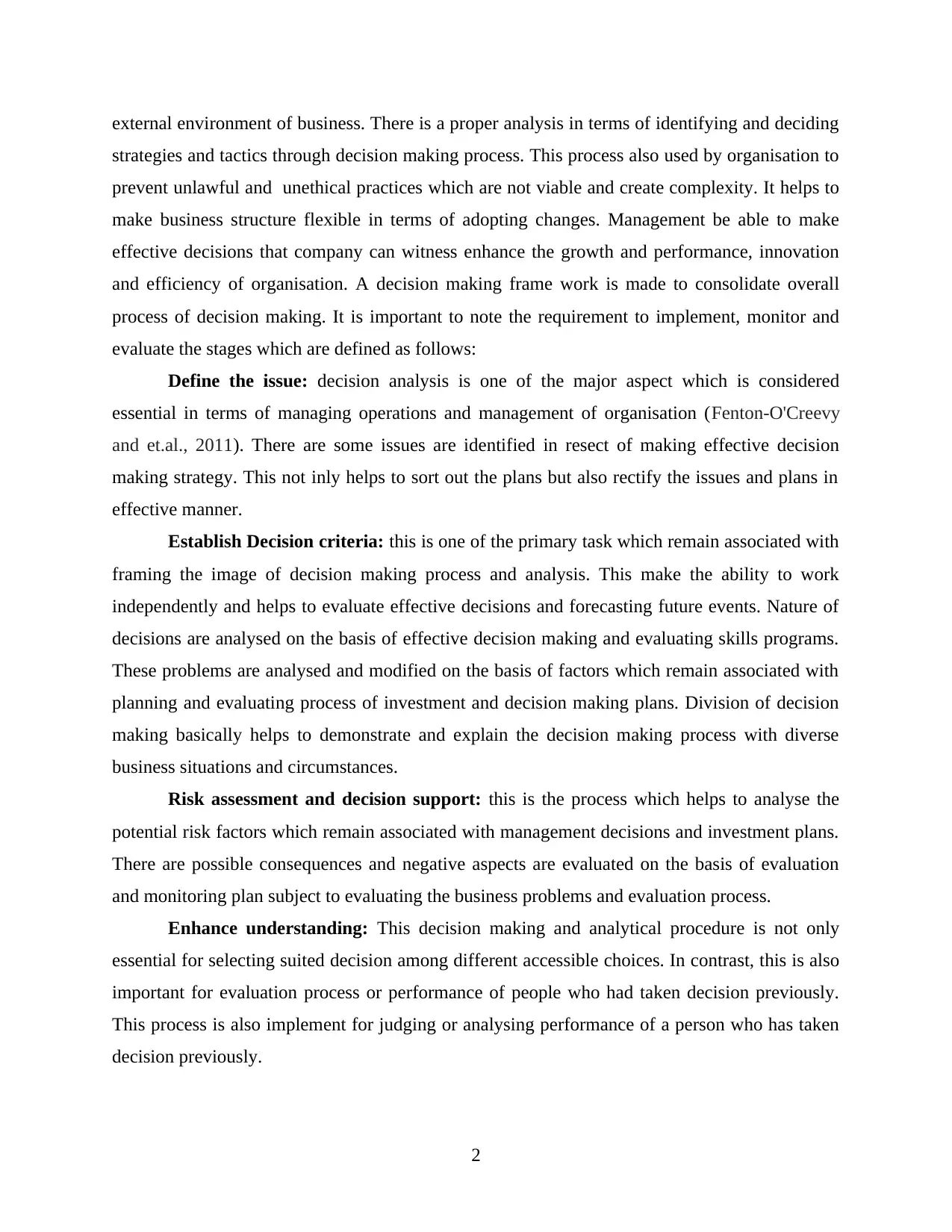
external environment of business. There is a proper analysis in terms of identifying and deciding
strategies and tactics through decision making process. This process also used by organisation to
prevent unlawful and unethical practices which are not viable and create complexity. It helps to
make business structure flexible in terms of adopting changes. Management be able to make
effective decisions that company can witness enhance the growth and performance, innovation
and efficiency of organisation. A decision making frame work is made to consolidate overall
process of decision making. It is important to note the requirement to implement, monitor and
evaluate the stages which are defined as follows:
Define the issue: decision analysis is one of the major aspect which is considered
essential in terms of managing operations and management of organisation (Fenton‐O'Creevy
and et.al., 2011). There are some issues are identified in resect of making effective decision
making strategy. This not inly helps to sort out the plans but also rectify the issues and plans in
effective manner.
Establish Decision criteria: this is one of the primary task which remain associated with
framing the image of decision making process and analysis. This make the ability to work
independently and helps to evaluate effective decisions and forecasting future events. Nature of
decisions are analysed on the basis of effective decision making and evaluating skills programs.
These problems are analysed and modified on the basis of factors which remain associated with
planning and evaluating process of investment and decision making plans. Division of decision
making basically helps to demonstrate and explain the decision making process with diverse
business situations and circumstances.
Risk assessment and decision support: this is the process which helps to analyse the
potential risk factors which remain associated with management decisions and investment plans.
There are possible consequences and negative aspects are evaluated on the basis of evaluation
and monitoring plan subject to evaluating the business problems and evaluation process.
Enhance understanding: This decision making and analytical procedure is not only
essential for selecting suited decision among different accessible choices. In contrast, this is also
important for evaluation process or performance of people who had taken decision previously.
This process is also implement for judging or analysing performance of a person who has taken
decision previously.
2
strategies and tactics through decision making process. This process also used by organisation to
prevent unlawful and unethical practices which are not viable and create complexity. It helps to
make business structure flexible in terms of adopting changes. Management be able to make
effective decisions that company can witness enhance the growth and performance, innovation
and efficiency of organisation. A decision making frame work is made to consolidate overall
process of decision making. It is important to note the requirement to implement, monitor and
evaluate the stages which are defined as follows:
Define the issue: decision analysis is one of the major aspect which is considered
essential in terms of managing operations and management of organisation (Fenton‐O'Creevy
and et.al., 2011). There are some issues are identified in resect of making effective decision
making strategy. This not inly helps to sort out the plans but also rectify the issues and plans in
effective manner.
Establish Decision criteria: this is one of the primary task which remain associated with
framing the image of decision making process and analysis. This make the ability to work
independently and helps to evaluate effective decisions and forecasting future events. Nature of
decisions are analysed on the basis of effective decision making and evaluating skills programs.
These problems are analysed and modified on the basis of factors which remain associated with
planning and evaluating process of investment and decision making plans. Division of decision
making basically helps to demonstrate and explain the decision making process with diverse
business situations and circumstances.
Risk assessment and decision support: this is the process which helps to analyse the
potential risk factors which remain associated with management decisions and investment plans.
There are possible consequences and negative aspects are evaluated on the basis of evaluation
and monitoring plan subject to evaluating the business problems and evaluation process.
Enhance understanding: This decision making and analytical procedure is not only
essential for selecting suited decision among different accessible choices. In contrast, this is also
important for evaluation process or performance of people who had taken decision previously.
This process is also implement for judging or analysing performance of a person who has taken
decision previously.
2
Paraphrase This Document
Need a fresh take? Get an instant paraphrase of this document with our AI Paraphraser
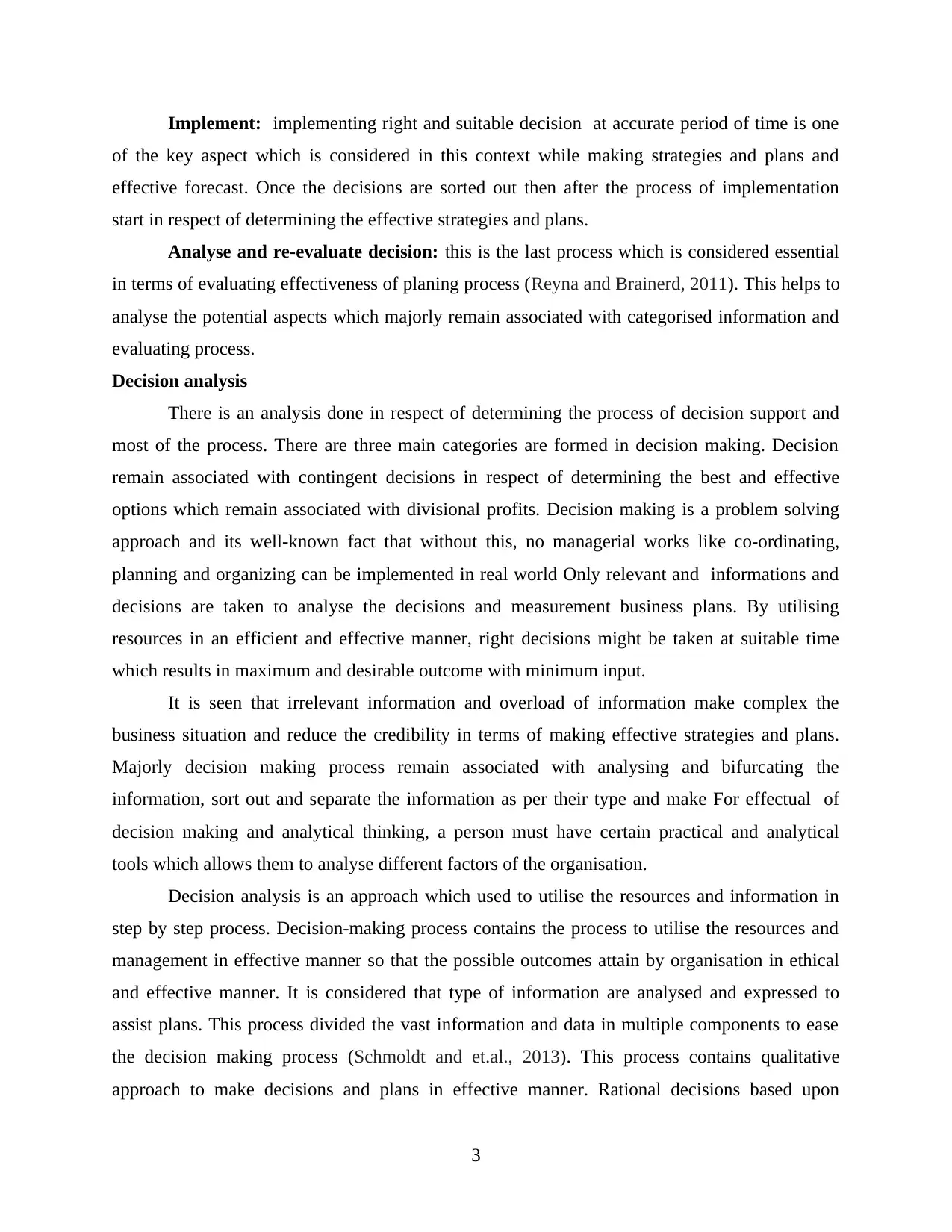
Implement: implementing right and suitable decision at accurate period of time is one
of the key aspect which is considered in this context while making strategies and plans and
effective forecast. Once the decisions are sorted out then after the process of implementation
start in respect of determining the effective strategies and plans.
Analyse and re-evaluate decision: this is the last process which is considered essential
in terms of evaluating effectiveness of planing process (Reyna and Brainerd, 2011). This helps to
analyse the potential aspects which majorly remain associated with categorised information and
evaluating process.
Decision analysis
There is an analysis done in respect of determining the process of decision support and
most of the process. There are three main categories are formed in decision making. Decision
remain associated with contingent decisions in respect of determining the best and effective
options which remain associated with divisional profits. Decision making is a problem solving
approach and its well-known fact that without this, no managerial works like co-ordinating,
planning and organizing can be implemented in real world Only relevant and informations and
decisions are taken to analyse the decisions and measurement business plans. By utilising
resources in an efficient and effective manner, right decisions might be taken at suitable time
which results in maximum and desirable outcome with minimum input.
It is seen that irrelevant information and overload of information make complex the
business situation and reduce the credibility in terms of making effective strategies and plans.
Majorly decision making process remain associated with analysing and bifurcating the
information, sort out and separate the information as per their type and make For effectual of
decision making and analytical thinking, a person must have certain practical and analytical
tools which allows them to analyse different factors of the organisation.
Decision analysis is an approach which used to utilise the resources and information in
step by step process. Decision-making process contains the process to utilise the resources and
management in effective manner so that the possible outcomes attain by organisation in ethical
and effective manner. It is considered that type of information are analysed and expressed to
assist plans. This process divided the vast information and data in multiple components to ease
the decision making process (Schmoldt and et.al., 2013). This process contains qualitative
approach to make decisions and plans in effective manner. Rational decisions based upon
3
of the key aspect which is considered in this context while making strategies and plans and
effective forecast. Once the decisions are sorted out then after the process of implementation
start in respect of determining the effective strategies and plans.
Analyse and re-evaluate decision: this is the last process which is considered essential
in terms of evaluating effectiveness of planing process (Reyna and Brainerd, 2011). This helps to
analyse the potential aspects which majorly remain associated with categorised information and
evaluating process.
Decision analysis
There is an analysis done in respect of determining the process of decision support and
most of the process. There are three main categories are formed in decision making. Decision
remain associated with contingent decisions in respect of determining the best and effective
options which remain associated with divisional profits. Decision making is a problem solving
approach and its well-known fact that without this, no managerial works like co-ordinating,
planning and organizing can be implemented in real world Only relevant and informations and
decisions are taken to analyse the decisions and measurement business plans. By utilising
resources in an efficient and effective manner, right decisions might be taken at suitable time
which results in maximum and desirable outcome with minimum input.
It is seen that irrelevant information and overload of information make complex the
business situation and reduce the credibility in terms of making effective strategies and plans.
Majorly decision making process remain associated with analysing and bifurcating the
information, sort out and separate the information as per their type and make For effectual of
decision making and analytical thinking, a person must have certain practical and analytical
tools which allows them to analyse different factors of the organisation.
Decision analysis is an approach which used to utilise the resources and information in
step by step process. Decision-making process contains the process to utilise the resources and
management in effective manner so that the possible outcomes attain by organisation in ethical
and effective manner. It is considered that type of information are analysed and expressed to
assist plans. This process divided the vast information and data in multiple components to ease
the decision making process (Schmoldt and et.al., 2013). This process contains qualitative
approach to make decisions and plans in effective manner. Rational decisions based upon
3
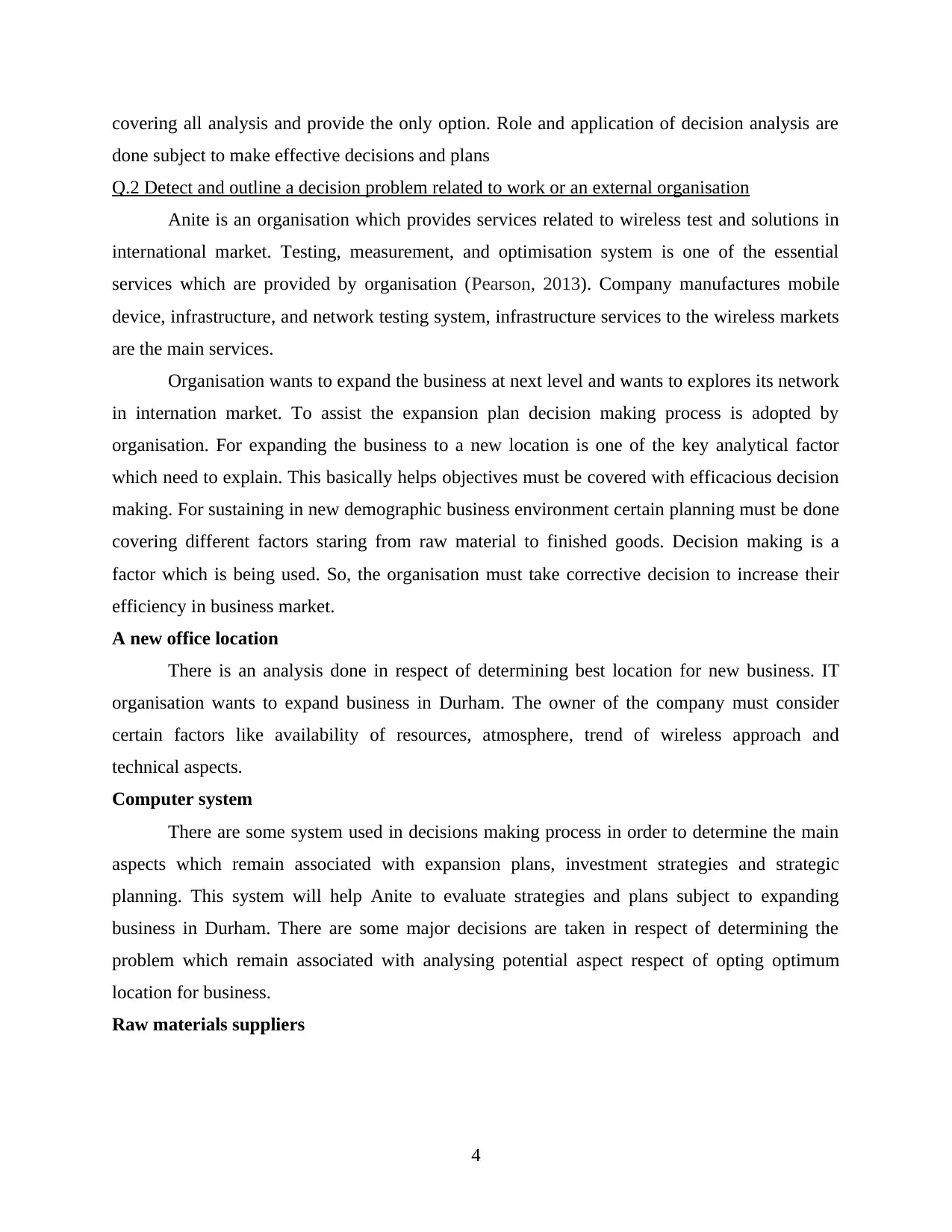
covering all analysis and provide the only option. Role and application of decision analysis are
done subject to make effective decisions and plans
Q.2 Detect and outline a decision problem related to work or an external organisation
Anite is an organisation which provides services related to wireless test and solutions in
international market. Testing, measurement, and optimisation system is one of the essential
services which are provided by organisation (Pearson, 2013). Company manufactures mobile
device, infrastructure, and network testing system, infrastructure services to the wireless markets
are the main services.
Organisation wants to expand the business at next level and wants to explores its network
in internation market. To assist the expansion plan decision making process is adopted by
organisation. For expanding the business to a new location is one of the key analytical factor
which need to explain. This basically helps objectives must be covered with efficacious decision
making. For sustaining in new demographic business environment certain planning must be done
covering different factors staring from raw material to finished goods. Decision making is a
factor which is being used. So, the organisation must take corrective decision to increase their
efficiency in business market.
A new office location
There is an analysis done in respect of determining best location for new business. IT
organisation wants to expand business in Durham. The owner of the company must consider
certain factors like availability of resources, atmosphere, trend of wireless approach and
technical aspects.
Computer system
There are some system used in decisions making process in order to determine the main
aspects which remain associated with expansion plans, investment strategies and strategic
planning. This system will help Anite to evaluate strategies and plans subject to expanding
business in Durham. There are some major decisions are taken in respect of determining the
problem which remain associated with analysing potential aspect respect of opting optimum
location for business.
Raw materials suppliers
4
done subject to make effective decisions and plans
Q.2 Detect and outline a decision problem related to work or an external organisation
Anite is an organisation which provides services related to wireless test and solutions in
international market. Testing, measurement, and optimisation system is one of the essential
services which are provided by organisation (Pearson, 2013). Company manufactures mobile
device, infrastructure, and network testing system, infrastructure services to the wireless markets
are the main services.
Organisation wants to expand the business at next level and wants to explores its network
in internation market. To assist the expansion plan decision making process is adopted by
organisation. For expanding the business to a new location is one of the key analytical factor
which need to explain. This basically helps objectives must be covered with efficacious decision
making. For sustaining in new demographic business environment certain planning must be done
covering different factors staring from raw material to finished goods. Decision making is a
factor which is being used. So, the organisation must take corrective decision to increase their
efficiency in business market.
A new office location
There is an analysis done in respect of determining best location for new business. IT
organisation wants to expand business in Durham. The owner of the company must consider
certain factors like availability of resources, atmosphere, trend of wireless approach and
technical aspects.
Computer system
There are some system used in decisions making process in order to determine the main
aspects which remain associated with expansion plans, investment strategies and strategic
planning. This system will help Anite to evaluate strategies and plans subject to expanding
business in Durham. There are some major decisions are taken in respect of determining the
problem which remain associated with analysing potential aspect respect of opting optimum
location for business.
Raw materials suppliers
4
⊘ This is a preview!⊘
Do you want full access?
Subscribe today to unlock all pages.

Trusted by 1+ million students worldwide
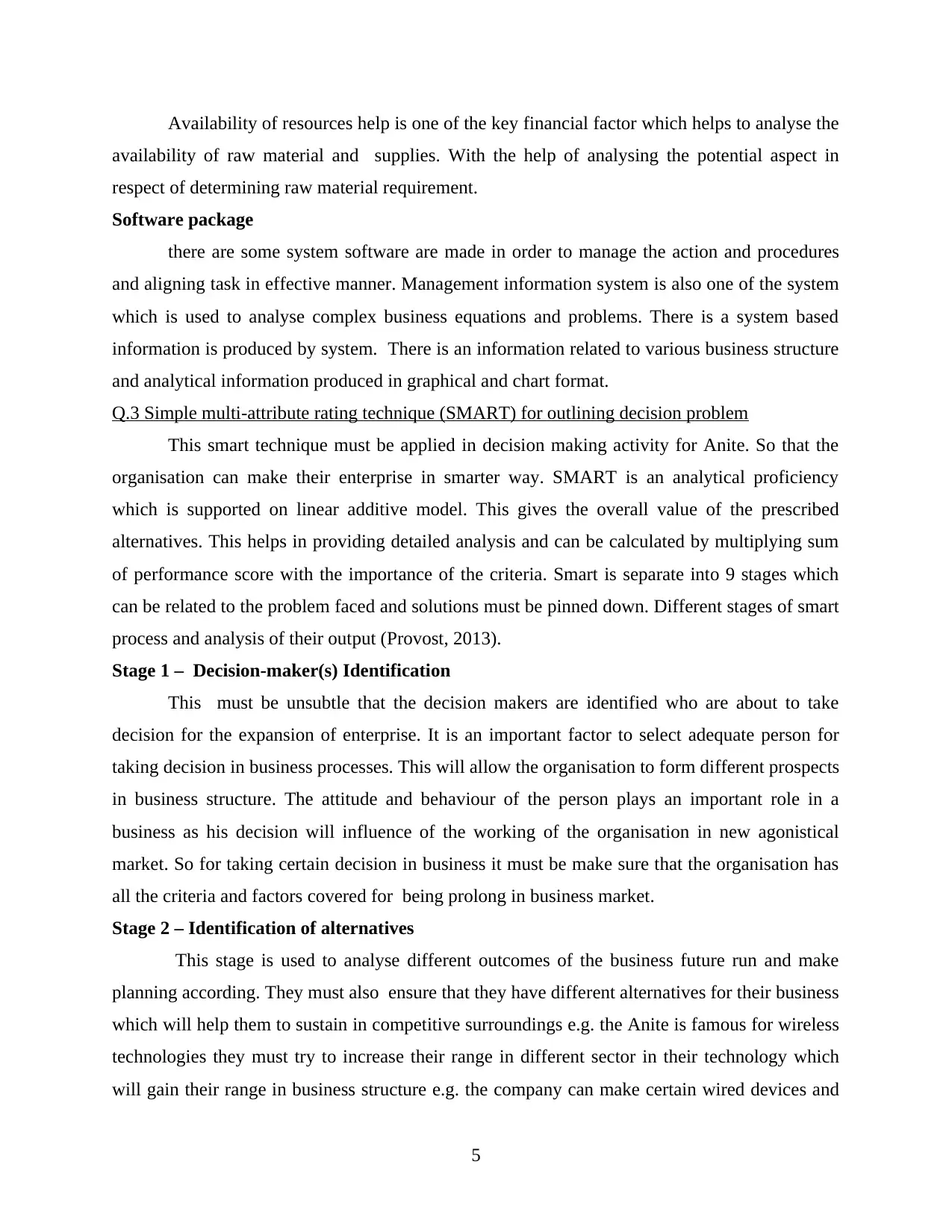
Availability of resources help is one of the key financial factor which helps to analyse the
availability of raw material and supplies. With the help of analysing the potential aspect in
respect of determining raw material requirement.
Software package
there are some system software are made in order to manage the action and procedures
and aligning task in effective manner. Management information system is also one of the system
which is used to analyse complex business equations and problems. There is a system based
information is produced by system. There is an information related to various business structure
and analytical information produced in graphical and chart format.
Q.3 Simple multi-attribute rating technique (SMART) for outlining decision problem
This smart technique must be applied in decision making activity for Anite. So that the
organisation can make their enterprise in smarter way. SMART is an analytical proficiency
which is supported on linear additive model. This gives the overall value of the prescribed
alternatives. This helps in providing detailed analysis and can be calculated by multiplying sum
of performance score with the importance of the criteria. Smart is separate into 9 stages which
can be related to the problem faced and solutions must be pinned down. Different stages of smart
process and analysis of their output (Provost, 2013).
Stage 1 – Decision-maker(s) Identification
This must be unsubtle that the decision makers are identified who are about to take
decision for the expansion of enterprise. It is an important factor to select adequate person for
taking decision in business processes. This will allow the organisation to form different prospects
in business structure. The attitude and behaviour of the person plays an important role in a
business as his decision will influence of the working of the organisation in new agonistical
market. So for taking certain decision in business it must be make sure that the organisation has
all the criteria and factors covered for being prolong in business market.
Stage 2 – Identification of alternatives
This stage is used to analyse different outcomes of the business future run and make
planning according. They must also ensure that they have different alternatives for their business
which will help them to sustain in competitive surroundings e.g. the Anite is famous for wireless
technologies they must try to increase their range in different sector in their technology which
will gain their range in business structure e.g. the company can make certain wired devices and
5
availability of raw material and supplies. With the help of analysing the potential aspect in
respect of determining raw material requirement.
Software package
there are some system software are made in order to manage the action and procedures
and aligning task in effective manner. Management information system is also one of the system
which is used to analyse complex business equations and problems. There is a system based
information is produced by system. There is an information related to various business structure
and analytical information produced in graphical and chart format.
Q.3 Simple multi-attribute rating technique (SMART) for outlining decision problem
This smart technique must be applied in decision making activity for Anite. So that the
organisation can make their enterprise in smarter way. SMART is an analytical proficiency
which is supported on linear additive model. This gives the overall value of the prescribed
alternatives. This helps in providing detailed analysis and can be calculated by multiplying sum
of performance score with the importance of the criteria. Smart is separate into 9 stages which
can be related to the problem faced and solutions must be pinned down. Different stages of smart
process and analysis of their output (Provost, 2013).
Stage 1 – Decision-maker(s) Identification
This must be unsubtle that the decision makers are identified who are about to take
decision for the expansion of enterprise. It is an important factor to select adequate person for
taking decision in business processes. This will allow the organisation to form different prospects
in business structure. The attitude and behaviour of the person plays an important role in a
business as his decision will influence of the working of the organisation in new agonistical
market. So for taking certain decision in business it must be make sure that the organisation has
all the criteria and factors covered for being prolong in business market.
Stage 2 – Identification of alternatives
This stage is used to analyse different outcomes of the business future run and make
planning according. They must also ensure that they have different alternatives for their business
which will help them to sustain in competitive surroundings e.g. the Anite is famous for wireless
technologies they must try to increase their range in different sector in their technology which
will gain their range in business structure e.g. the company can make certain wired devices and
5
Paraphrase This Document
Need a fresh take? Get an instant paraphrase of this document with our AI Paraphraser
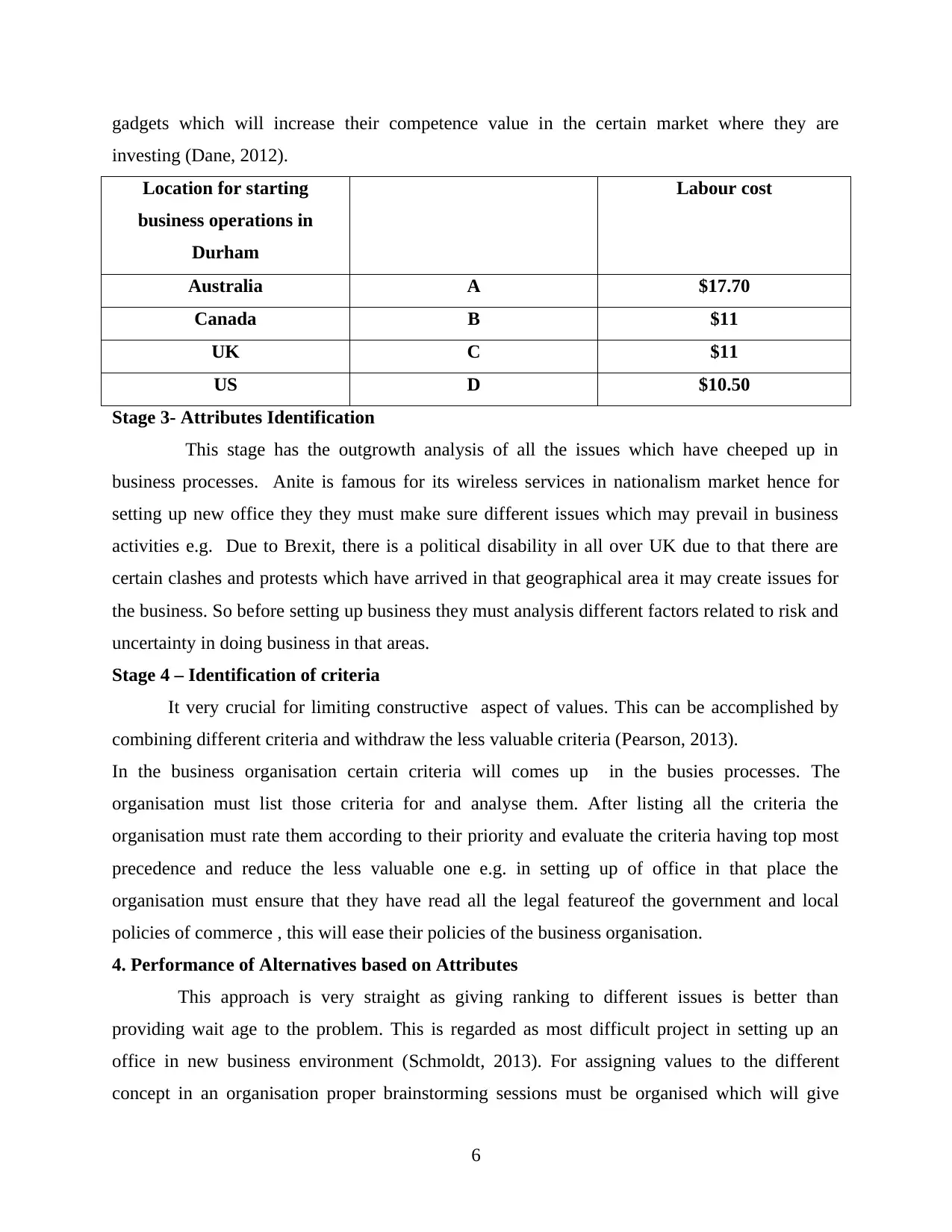
gadgets which will increase their competence value in the certain market where they are
investing (Dane, 2012).
Location for starting
business operations in
Durham
Labour cost
Australia A $17.70
Canada B $11
UK C $11
US D $10.50
Stage 3- Attributes Identification
This stage has the outgrowth analysis of all the issues which have cheeped up in
business processes. Anite is famous for its wireless services in nationalism market hence for
setting up new office they they must make sure different issues which may prevail in business
activities e.g. Due to Brexit, there is a political disability in all over UK due to that there are
certain clashes and protests which have arrived in that geographical area it may create issues for
the business. So before setting up business they must analysis different factors related to risk and
uncertainty in doing business in that areas.
Stage 4 – Identification of criteria
It very crucial for limiting constructive aspect of values. This can be accomplished by
combining different criteria and withdraw the less valuable criteria (Pearson, 2013).
In the business organisation certain criteria will comes up in the busies processes. The
organisation must list those criteria for and analyse them. After listing all the criteria the
organisation must rate them according to their priority and evaluate the criteria having top most
precedence and reduce the less valuable one e.g. in setting up of office in that place the
organisation must ensure that they have read all the legal featureof the government and local
policies of commerce , this will ease their policies of the business organisation.
4. Performance of Alternatives based on Attributes
This approach is very straight as giving ranking to different issues is better than
providing wait age to the problem. This is regarded as most difficult project in setting up an
office in new business environment (Schmoldt, 2013). For assigning values to the different
concept in an organisation proper brainstorming sessions must be organised which will give
6
investing (Dane, 2012).
Location for starting
business operations in
Durham
Labour cost
Australia A $17.70
Canada B $11
UK C $11
US D $10.50
Stage 3- Attributes Identification
This stage has the outgrowth analysis of all the issues which have cheeped up in
business processes. Anite is famous for its wireless services in nationalism market hence for
setting up new office they they must make sure different issues which may prevail in business
activities e.g. Due to Brexit, there is a political disability in all over UK due to that there are
certain clashes and protests which have arrived in that geographical area it may create issues for
the business. So before setting up business they must analysis different factors related to risk and
uncertainty in doing business in that areas.
Stage 4 – Identification of criteria
It very crucial for limiting constructive aspect of values. This can be accomplished by
combining different criteria and withdraw the less valuable criteria (Pearson, 2013).
In the business organisation certain criteria will comes up in the busies processes. The
organisation must list those criteria for and analyse them. After listing all the criteria the
organisation must rate them according to their priority and evaluate the criteria having top most
precedence and reduce the less valuable one e.g. in setting up of office in that place the
organisation must ensure that they have read all the legal featureof the government and local
policies of commerce , this will ease their policies of the business organisation.
4. Performance of Alternatives based on Attributes
This approach is very straight as giving ranking to different issues is better than
providing wait age to the problem. This is regarded as most difficult project in setting up an
office in new business environment (Schmoldt, 2013). For assigning values to the different
concept in an organisation proper brainstorming sessions must be organised which will give
6
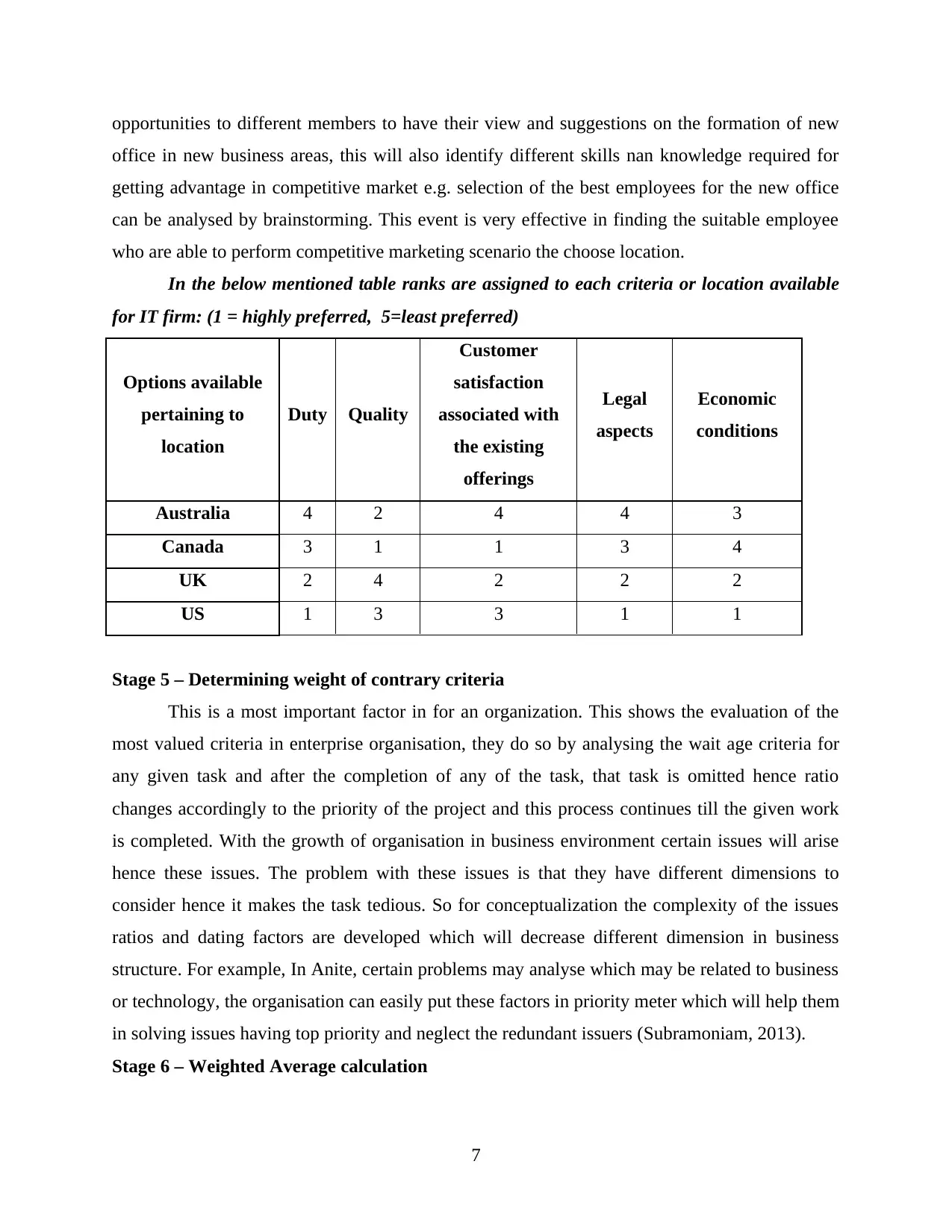
opportunities to different members to have their view and suggestions on the formation of new
office in new business areas, this will also identify different skills nan knowledge required for
getting advantage in competitive market e.g. selection of the best employees for the new office
can be analysed by brainstorming. This event is very effective in finding the suitable employee
who are able to perform competitive marketing scenario the choose location.
In the below mentioned table ranks are assigned to each criteria or location available
for IT firm: (1 = highly preferred, 5=least preferred)
Options available
pertaining to
location
Duty Quality
Customer
satisfaction
associated with
the existing
offerings
Legal
aspects
Economic
conditions
Australia 4 2 4 4 3
Canada 3 1 1 3 4
UK 2 4 2 2 2
US 1 3 3 1 1
Stage 5 – Determining weight of contrary criteria
This is a most important factor in for an organization. This shows the evaluation of the
most valued criteria in enterprise organisation, they do so by analysing the wait age criteria for
any given task and after the completion of any of the task, that task is omitted hence ratio
changes accordingly to the priority of the project and this process continues till the given work
is completed. With the growth of organisation in business environment certain issues will arise
hence these issues. The problem with these issues is that they have different dimensions to
consider hence it makes the task tedious. So for conceptualization the complexity of the issues
ratios and dating factors are developed which will decrease different dimension in business
structure. For example, In Anite, certain problems may analyse which may be related to business
or technology, the organisation can easily put these factors in priority meter which will help them
in solving issues having top priority and neglect the redundant issuers (Subramoniam, 2013).
Stage 6 – Weighted Average calculation
7
office in new business areas, this will also identify different skills nan knowledge required for
getting advantage in competitive market e.g. selection of the best employees for the new office
can be analysed by brainstorming. This event is very effective in finding the suitable employee
who are able to perform competitive marketing scenario the choose location.
In the below mentioned table ranks are assigned to each criteria or location available
for IT firm: (1 = highly preferred, 5=least preferred)
Options available
pertaining to
location
Duty Quality
Customer
satisfaction
associated with
the existing
offerings
Legal
aspects
Economic
conditions
Australia 4 2 4 4 3
Canada 3 1 1 3 4
UK 2 4 2 2 2
US 1 3 3 1 1
Stage 5 – Determining weight of contrary criteria
This is a most important factor in for an organization. This shows the evaluation of the
most valued criteria in enterprise organisation, they do so by analysing the wait age criteria for
any given task and after the completion of any of the task, that task is omitted hence ratio
changes accordingly to the priority of the project and this process continues till the given work
is completed. With the growth of organisation in business environment certain issues will arise
hence these issues. The problem with these issues is that they have different dimensions to
consider hence it makes the task tedious. So for conceptualization the complexity of the issues
ratios and dating factors are developed which will decrease different dimension in business
structure. For example, In Anite, certain problems may analyse which may be related to business
or technology, the organisation can easily put these factors in priority meter which will help them
in solving issues having top priority and neglect the redundant issuers (Subramoniam, 2013).
Stage 6 – Weighted Average calculation
7
⊘ This is a preview!⊘
Do you want full access?
Subscribe today to unlock all pages.

Trusted by 1+ million students worldwide
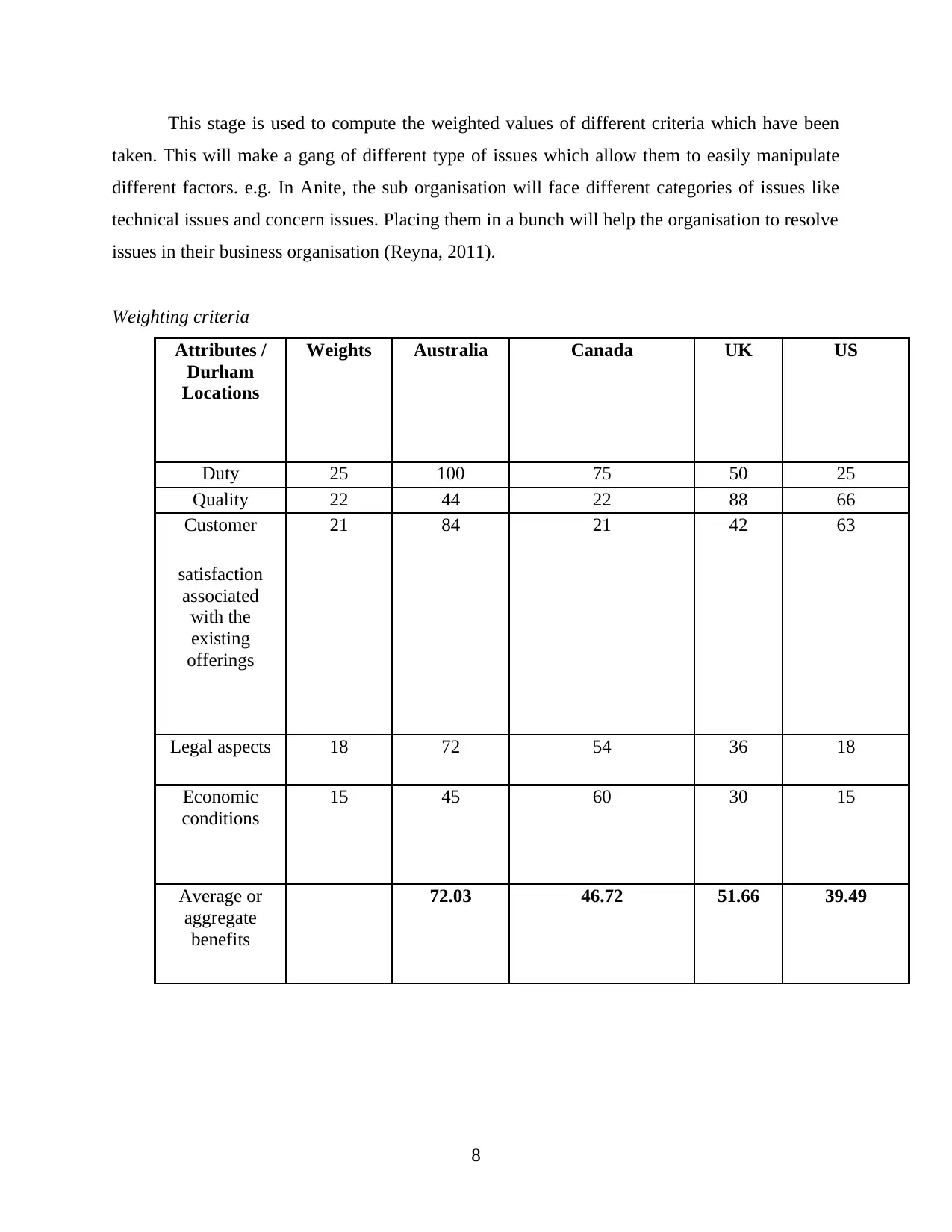
This stage is used to compute the weighted values of different criteria which have been
taken. This will make a gang of different type of issues which allow them to easily manipulate
different factors. e.g. In Anite, the sub organisation will face different categories of issues like
technical issues and concern issues. Placing them in a bunch will help the organisation to resolve
issues in their business organisation (Reyna, 2011).
Weighting criteria
Attributes /
Durham
Locations
Weights Australia Canada UK US
Duty 25 100 75 50 25
Quality 22 44 22 88 66
Customer 21 84 21 42 63
satisfaction
associated
with the
existing
offerings
Legal aspects 18 72 54 36 18
Economic
conditions
15 45 60 30 15
Average or
aggregate
benefits
72.03 46.72 51.66 39.49
8
taken. This will make a gang of different type of issues which allow them to easily manipulate
different factors. e.g. In Anite, the sub organisation will face different categories of issues like
technical issues and concern issues. Placing them in a bunch will help the organisation to resolve
issues in their business organisation (Reyna, 2011).
Weighting criteria
Attributes /
Durham
Locations
Weights Australia Canada UK US
Duty 25 100 75 50 25
Quality 22 44 22 88 66
Customer 21 84 21 42 63
satisfaction
associated
with the
existing
offerings
Legal aspects 18 72 54 36 18
Economic
conditions
15 45 60 30 15
Average or
aggregate
benefits
72.03 46.72 51.66 39.49
8
Paraphrase This Document
Need a fresh take? Get an instant paraphrase of this document with our AI Paraphraser
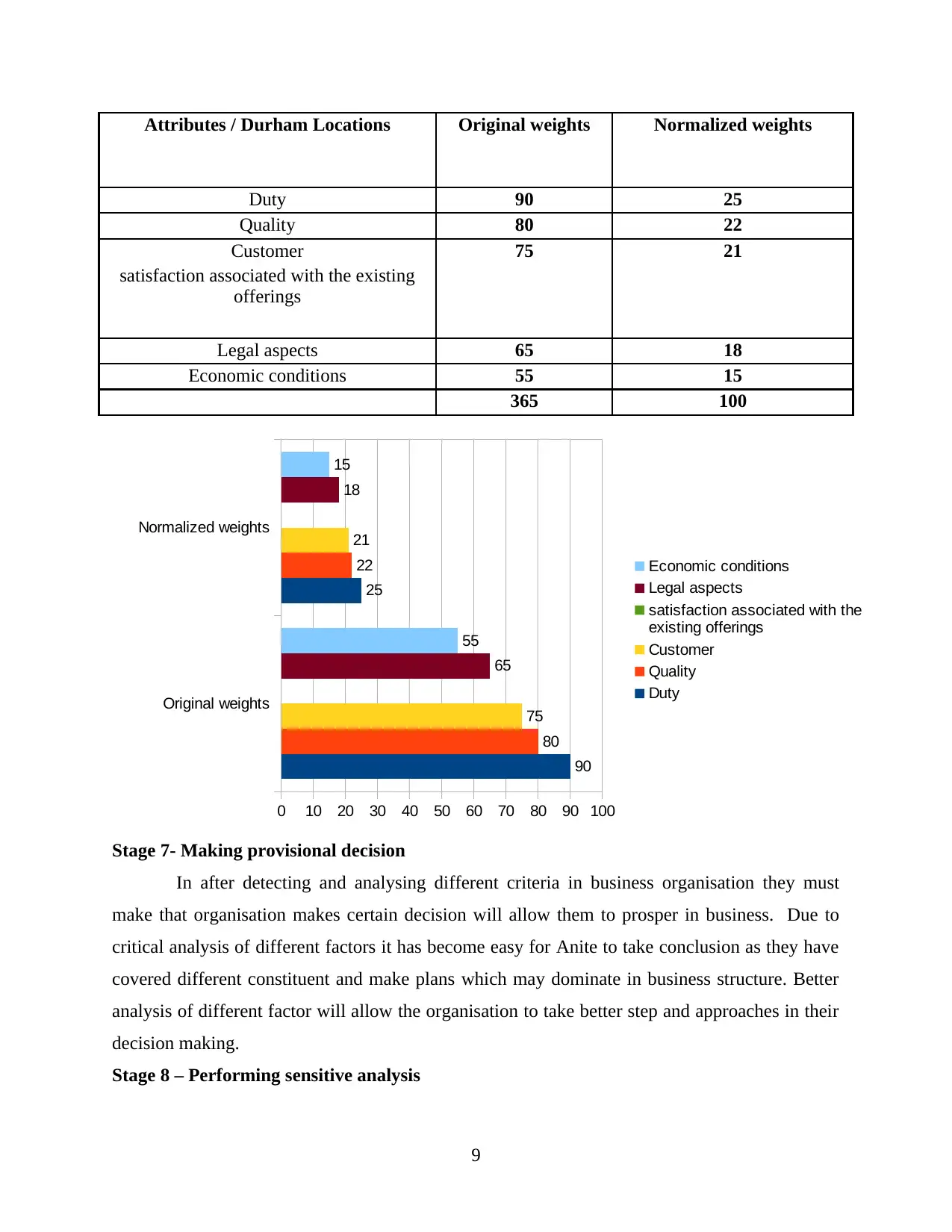
Attributes / Durham Locations Original weights Normalized weights
Duty 90 25
Quality 80 22
Customer 75 21
satisfaction associated with the existing
offerings
Legal aspects 65 18
Economic conditions 55 15
365 100
Stage 7- Making provisional decision
In after detecting and analysing different criteria in business organisation they must
make that organisation makes certain decision will allow them to prosper in business. Due to
critical analysis of different factors it has become easy for Anite to take conclusion as they have
covered different constituent and make plans which may dominate in business structure. Better
analysis of different factor will allow the organisation to take better step and approaches in their
decision making.
Stage 8 – Performing sensitive analysis
9
Original weights
Normalized weights
0 10 20 30 40 50 60 70 80 90 100
90
25
80
22
75
21
65
18
55
15
Economic conditions
Legal aspects
satisfaction associated with the
existing offerings
Customer
Quality
Duty
Duty 90 25
Quality 80 22
Customer 75 21
satisfaction associated with the existing
offerings
Legal aspects 65 18
Economic conditions 55 15
365 100
Stage 7- Making provisional decision
In after detecting and analysing different criteria in business organisation they must
make that organisation makes certain decision will allow them to prosper in business. Due to
critical analysis of different factors it has become easy for Anite to take conclusion as they have
covered different constituent and make plans which may dominate in business structure. Better
analysis of different factor will allow the organisation to take better step and approaches in their
decision making.
Stage 8 – Performing sensitive analysis
9
Original weights
Normalized weights
0 10 20 30 40 50 60 70 80 90 100
90
25
80
22
75
21
65
18
55
15
Economic conditions
Legal aspects
satisfaction associated with the
existing offerings
Customer
Quality
Duty
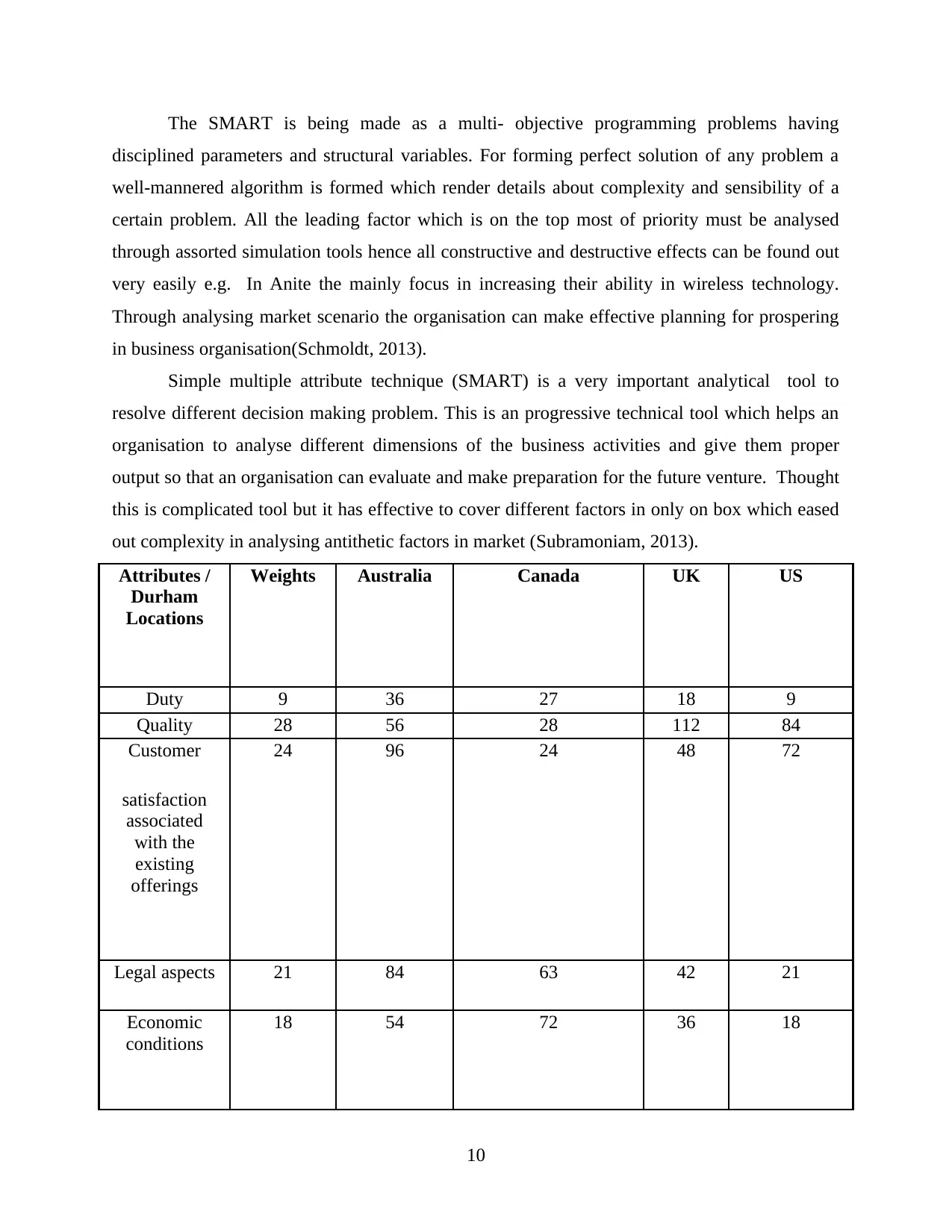
The SMART is being made as a multi- objective programming problems having
disciplined parameters and structural variables. For forming perfect solution of any problem a
well-mannered algorithm is formed which render details about complexity and sensibility of a
certain problem. All the leading factor which is on the top most of priority must be analysed
through assorted simulation tools hence all constructive and destructive effects can be found out
very easily e.g. In Anite the mainly focus in increasing their ability in wireless technology.
Through analysing market scenario the organisation can make effective planning for prospering
in business organisation(Schmoldt, 2013).
Simple multiple attribute technique (SMART) is a very important analytical tool to
resolve different decision making problem. This is an progressive technical tool which helps an
organisation to analyse different dimensions of the business activities and give them proper
output so that an organisation can evaluate and make preparation for the future venture. Thought
this is complicated tool but it has effective to cover different factors in only on box which eased
out complexity in analysing antithetic factors in market (Subramoniam, 2013).
Attributes /
Durham
Locations
Weights Australia Canada UK US
Duty 9 36 27 18 9
Quality 28 56 28 112 84
Customer 24 96 24 48 72
satisfaction
associated
with the
existing
offerings
Legal aspects 21 84 63 42 21
Economic
conditions
18 54 72 36 18
10
disciplined parameters and structural variables. For forming perfect solution of any problem a
well-mannered algorithm is formed which render details about complexity and sensibility of a
certain problem. All the leading factor which is on the top most of priority must be analysed
through assorted simulation tools hence all constructive and destructive effects can be found out
very easily e.g. In Anite the mainly focus in increasing their ability in wireless technology.
Through analysing market scenario the organisation can make effective planning for prospering
in business organisation(Schmoldt, 2013).
Simple multiple attribute technique (SMART) is a very important analytical tool to
resolve different decision making problem. This is an progressive technical tool which helps an
organisation to analyse different dimensions of the business activities and give them proper
output so that an organisation can evaluate and make preparation for the future venture. Thought
this is complicated tool but it has effective to cover different factors in only on box which eased
out complexity in analysing antithetic factors in market (Subramoniam, 2013).
Attributes /
Durham
Locations
Weights Australia Canada UK US
Duty 9 36 27 18 9
Quality 28 56 28 112 84
Customer 24 96 24 48 72
satisfaction
associated
with the
existing
offerings
Legal aspects 21 84 63 42 21
Economic
conditions
18 54 72 36 18
10
⊘ This is a preview!⊘
Do you want full access?
Subscribe today to unlock all pages.

Trusted by 1+ million students worldwide
1 out of 16
Related Documents
Your All-in-One AI-Powered Toolkit for Academic Success.
+13062052269
info@desklib.com
Available 24*7 on WhatsApp / Email
![[object Object]](/_next/static/media/star-bottom.7253800d.svg)
Unlock your academic potential
Copyright © 2020–2025 A2Z Services. All Rights Reserved. Developed and managed by ZUCOL.





